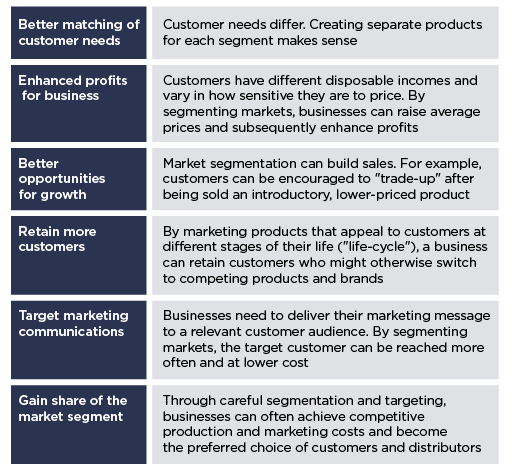Challenge 4 Know your customer
Who are your customers?
At one level, asking if you know who your organisation’s customers are, may seem simplistic and obvious and not much of a challenge. However many large organisations, as you saw from Challenge 3 [Tip: hold Ctrl and click a link to open it in a new tab. (Hide tip)] , have employees engaged in work running the organisation without direct sight or contact with the end customers or users. To be commercially aware is to have more than a superficial understanding of customers.
There are many reasons why a better understanding of customers is central to commercial awareness. Not all customers are the same, even if it is company policy to treat them that way.
Knowing more about their customers allows the organisation to adjust and adapt its products, service levels, targeting and marketing, and to focus resources generally on where they are most likely to achieve a return.
Customers can be grouped by characteristics that describe them. This is called segmentation. Market segmentation splits the market into different types (segments) according to such dynamics as the:
benefits they want
amount they are able, or willing to pay
media (e.g. online, television, newspapers, and magazines) they see or use
quantities they buy
time and place that they buy.
Rather than treating all customers the same, market segmentation makes it possible for firms to tailor the marketing mix (product, price, promotion, distribution channels, etc.) for specific target markets, thus better satisfying customer needs.
For a market segment to be distinct it should be:
measurable and quantifiable in its influence on the business
accessible by communication and distribution channels (if you cannot reach them they will not know you exist)
sufficiently different in its response to a marketing mix (product and service features, distribution channels, pricing and communication) from other customers
durable (not changing to quickly)
substantial enough to be profitable (i.e. not too small or costly to serve).
A market can be segmented by various bases, and industrial markets are segmented somewhat differently from consumer markets.
Hints and tips
To learn more about this read tips 8 and 9 in the Hints and tips section.
There may be several relevant ways of grouping customers depending upon whether you work in sales or marketing (e.g. to understand buying behaviour), product development (e.g. understanding what features or service is important) or distribution (e.g. to understand how you can provide access to products or services through intermediaries or retail/wholesale outlets) and so on.
Another way of grouping customers is by their value to the organisation as measured by how much they spend, volume of use, frequency of purchase, and whether they are new or recent customers or longstanding loyal ones.
Market segmentation offers the following potential benefits to a business:
Some customers contribute more revenues by buying more than others. Others consume more resources (e.g. super-users) which may make the cost to serve them more but, ideally, also means that they contribute a lot of value to the organisation.
Some buy directly from the organisation and others through intermediaries like shops or brokers. Perhaps your customers are internal to the organisation in that you provide a service to other departments.
Now answer some of these questions before you undertake a short investigation as part of today’s challenge.
How are customers described in your organisation – customers, clients, consumers, users, and accounts are some examples, but what about where you work?
Does the organisation sell directly to customers (e.g. online, direct delivery, through its own retail outlets)?
Does the organisation sell through intermediaries that represent your organisation and, potentially, others too?
Does the organisation differentiate between customer groups or segments by their needs, usage or motivations for using products or services?
Does the organisation make any special provision for either new customers or longstanding or loyal customers?
Do you know what the organisation’s ideal customer looks like?
Are there any VIP customers or people who are advocates? Who looks after them? Why are they VIPs?
How many reasons can you think of for an employee, who is not in direct contact with customers, to have a good understanding of the organisation’s customers and how they are segmented?
Does your organisation identify how different customers are managed or treated? How does it differ for each type?
Does your organisation differentiate its products or service for different customer types?
How many answers did you know well enough to explain to a colleague what type of customers your organisation has or how it gets new customers?
Could you name a customer and provide a profile of them?
Could you describe how you manage existing customers and, if relevant, recover those at risk of leaving if this happens.
If so then you have effectively just made a summary of your organisation’s customer strategy.
Hints and tips
If you would like to check your answers take a look at tip 10 in the Hints and tips section.
Your quest today considers why it is important that you understand who buys or uses your products or services and how you can find out more about them. One clue to this might be to consider the consequences of not knowing about customers and how the organisation relates to them.
Now you can go to Challenge 5 Making sense of it all.

